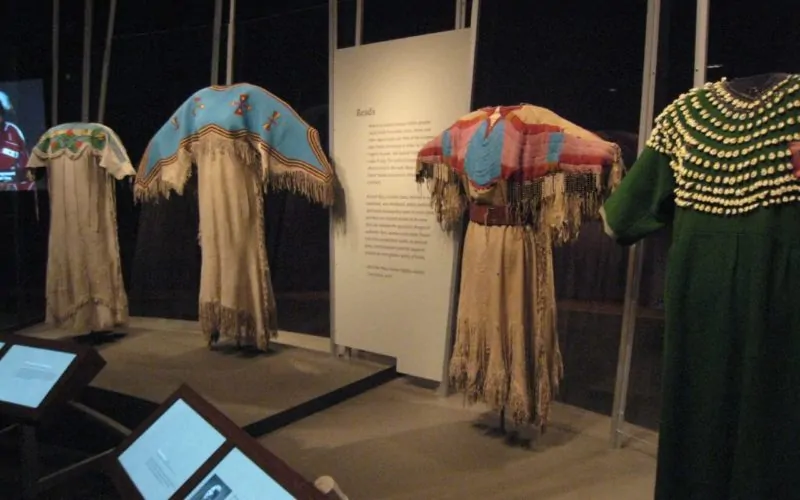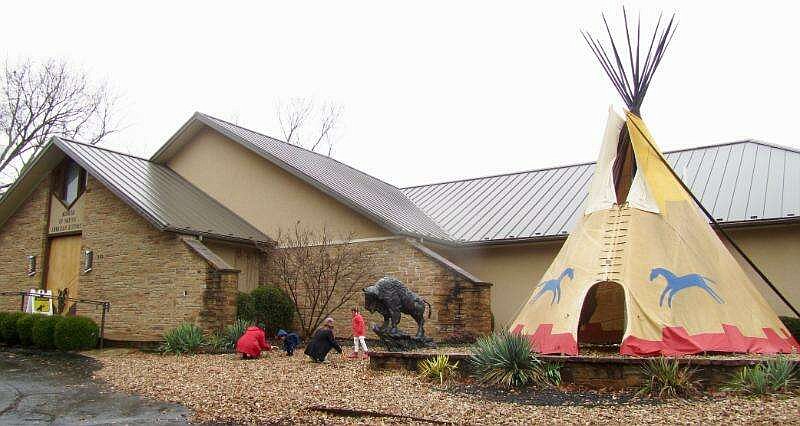
Optimizing the Experiential Journey: A Comprehensive Guide to Timing Your Visit to Native American Museums
The decision of when to visit a Native American museum is a multifaceted one, extending beyond mere logistical convenience to encompass the depth of the educational and cultural experience. Unlike a simple tourist attraction, these institutions serve as vital repositories of Indigenous history, art, and contemporary life, offering profound insights into the diverse cultures of Native peoples across the Americas. This encyclopedic guide delves into the optimal times for such visits, considering seasonal variations, institutional programming, regional specificities, and the overarching goal of fostering a respectful and enriching engagement.
I. Defining "Best Time": A Multifaceted Approach
The "best time" to visit a Native American museum is not a singular, universally applicable answer but rather a dynamic interplay of several critical factors:
- Personal Objectives: Are you seeking a quiet, contemplative experience for in-depth study, or a more vibrant, event-filled visit?
- Museum Programming: The schedule of special exhibitions, workshops, lectures, and cultural performances.
- Regional Climate and Geography: The physical comfort of travel and the conditions of surrounding cultural sites.
- Crowd Levels and Atmosphere: The impact of visitor volume on the quality of engagement.
- Travel Logistics and Cost: The financial implications of peak versus off-peak seasons.
- Respect for Indigenous Communities: Awareness of local cultural calendars and the potential impact of tourism.

By systematically evaluating these elements, visitors can tailor their timing to achieve the most meaningful and impactful experience.
II. Seasonal Considerations for Museum Visits

A. Spring (March – May): A Period of Renewal and Emerging Activity
- Advantages:
- Mild Weather: Across most of North America, spring offers pleasant temperatures, ideal for travel and exploring outdoor museum components or nearby cultural sites (e.g., ancient ruins in the Southwest like Mesa Verde, or effigy mounds in the Midwest).
- Moderate Crowds: Generally, spring sees fewer tourists than the peak summer months, allowing for a more serene and contemplative museum experience. School groups may be present, particularly in late spring, but overall individual visitor traffic is lighter.
- Emerging Cultural Events: Many Indigenous communities begin their public cultural calendars in spring, often coinciding with planting seasons or ceremonial preparations. Museums frequently host related programming, such as traditional craft demonstrations or talks on ecological knowledge.
- Natural Beauty: The blossoming of flora can enhance visits to museums situated in scenic areas or those with outdoor exhibits.
- Disadvantages:
- Spring Break: Certain weeks in March and April can see spikes in family travel, leading to localized increases in museum attendance, particularly in major tourist destinations.
- Unpredictable Weather: Early spring, especially in northern regions, can still experience wintry conditions or sudden shifts in temperature.
B. Summer (June – August): Peak Season for Families and Major Festivals
- Advantages:
- Extensive Programming: Museums often schedule their most ambitious and family-friendly programming during the summer months to capitalize on school holidays. This includes new major exhibitions, children’s workshops, and outdoor performances.
- Major Cultural Festivals: Summer is synonymous with large-scale Indigenous cultural gatherings, powwows, and art markets (e.g., Santa Fe Indian Market in August). Museums in these regions often serve as central hubs or offer complementary exhibits.
- Accessible Travel: Longer daylight hours and generally stable weather across the continent facilitate travel, especially for families.
- Disadvantages:
- High Crowds: This is the peak tourist season, resulting in significant museum attendance. This can lead to longer lines, crowded galleries, and a less intimate viewing experience.
- Increased Costs: Airfare, accommodation, and rental car prices are typically at their highest during the summer.
- Extreme Heat: Southern and Southwestern regions can experience intensely hot temperatures, making outdoor exploration uncomfortable or even hazardous.
C. Autumn (September – November): Ideal Conditions for Depth and Serenity
- Advantages:
- Optimal Weather: Across much of North America, autumn boasts crisp, comfortable temperatures and often stunning fall foliage, creating an ideal environment for travel and exploration.
- Reduced Crowds: After the summer rush subsides and before holiday travel begins, autumn generally offers a significant decrease in museum visitors. This allows for more personal space, easier navigation of exhibits, and better opportunities for quiet reflection.
- Harvest Festivals and Traditional Events: Many Indigenous cultures celebrate harvest-related ceremonies and events in autumn. Museums may feature relevant programming or exhibits that explore these traditions.
- Academic Season: For researchers and students, the start of the academic year often means a renewed focus on scholarly pursuits, making autumn a conducive time for in-depth museum visits.
- Disadvantages:
- Shorter Days: Daylight hours begin to diminish, which might affect outdoor activities if museums are part of a broader itinerary involving cultural sites.
- Thanksgiving Travel: The week of American Thanksgiving (late November) can see a temporary surge in travel and museum attendance.
D. Winter (December – February): A Time for Quiet Contemplation and Special Focus
- Advantages:
- Lowest Crowds: Winter generally represents the absolute off-peak season for tourism, leading to the fewest visitors. This offers the most intimate and unhurried museum experience, ideal for deep engagement with exhibits.
- Lower Costs: Travel and accommodation prices are typically at their lowest, excluding the holiday weeks around Christmas and New Year’s.
- Unique Programming: Some museums offer special winter-themed exhibits, lectures, or workshops that delve into winter traditions, storytelling, or specific art forms practiced during colder months.
- Contemplative Atmosphere: The quietude of winter can foster a more reflective and focused engagement with the profound narratives presented in Native American museums.
- Disadvantages:
- Weather Challenges: Northern regions can experience severe winter weather (snow, ice, extreme cold), potentially disrupting travel plans or limiting access to some outdoor sites.
- Reduced Hours: Some smaller museums or cultural centers may operate on reduced winter hours or even close temporarily.
- Holiday Peaks: The weeks surrounding Christmas and New Year’s can see temporary spikes in visitor numbers and travel costs.
- Fewer Outdoor Cultural Events: Many outdoor Indigenous cultural events are not held during the colder months.
III. Factors Influencing Optimal Timing Beyond Seasons
A. Special Exhibitions and Cultural Events:
This is arguably the most critical factor. Many Native American museums, such as the Smithsonian National Museum of the American Indian (NMAI) or the Heard Museum, host temporary exhibitions of extraordinary significance, bringing together rare artifacts or contemporary works that may only be on display for a limited time. Similarly, they might host artist-in-residence programs, traditional dance performances, storytelling sessions, or academic symposia. Proactive research of the specific museum’s calendar is paramount. Aligning your visit with an event that deeply resonates with your interests can transform a standard visit into an extraordinary one.
B. Crowd Avoidance and Serenity:
For many, the ability to engage deeply with the narratives, art, and history presented requires a degree of quiet and unhurried contemplation. Off-peak seasons (autumn and winter) and weekdays (Tuesday through Thursday) are generally the best for avoiding large crowds. This allows for closer examination of artifacts, more time to read interpretive panels, and potentially more opportunities for informal interaction with museum staff or docents.
C. Weather and Regional Nuances:
The vast geographical spread of Native American museums necessitates a regional approach to weather considerations:
- Southwest (Arizona, New Mexico): Spring and autumn are ideal, with mild temperatures. Summer can be intensely hot, making outdoor exploration of sites like Chaco Canyon or Canyon de Chelly challenging. Winter is generally pleasant and sunny.
- Northeast/Midwest: Spring and autumn offer comfortable temperatures and beautiful scenery. Summer can be humid, and winter can be very cold and snowy, potentially impacting travel.
- Pacific Northwest: While beautiful, the region experiences significant rainfall from late autumn through spring. Summer offers the driest and most pleasant weather.
- Southeast: Summers are hot and humid. Spring and autumn provide much more comfortable conditions.
D. Travel Costs and Accessibility:
Budget-conscious travelers will find the most favorable prices for flights and accommodation during the off-peak seasons (late autumn, winter, and early spring, excluding major holidays). This can significantly reduce the overall cost of the trip, potentially allowing for extended stays or visits to multiple institutions.
E. Personal Interest and Research Focus:
Academics, researchers, or individuals pursuing in-depth study will likely prioritize a tranquil environment over bustling cultural events. Their "best time" would typically be the quieter periods of autumn or winter weekdays, allowing for focused research, access to library resources, and potentially pre-arranged appointments with curatorial staff (though such access always requires prior arrangement and is subject to institutional policy).
F. Respect for Indigenous Communities:
When planning a visit, it is crucial to remember that Native American museums are not isolated entities but are often deeply connected to living Indigenous communities. Some cultural events or ceremonies held by these communities may not be public or may have specific protocols for visitors. While museums typically respect these boundaries, visitors should be mindful of local customs if their visit extends beyond the museum walls. Attending public powwows or cultural festivals can be incredibly enriching, but always approach with respect, humility, and an openness to learning.
IV. Researching Your Visit: Essential Steps
To pinpoint the truly "best time" for your visit, detailed planning is indispensable:
- Consult Museum Websites: This is the primary source for exhibition schedules, event calendars, operating hours, and any special announcements. Pay attention to dates for temporary closures or extended hours.
- Check Local Tourism Boards: These can provide information on regional festivals, weather patterns, and accommodation options.
- Review Social Media: Museums often use platforms like Facebook, Instagram, and Twitter to announce last-minute events, workshops, or changes in schedule.
- Contact the Museum Directly: For specific inquiries about accessibility, research opportunities, or to confirm event details, a direct phone call or email can be invaluable.
V. Conclusion
Ultimately, the "best time of year to visit Native American museums" is a highly individualized determination, predicated on a blend of personal interest, pragmatic considerations, and a deep respect for the cultural heritage being presented. While autumn and spring generally offer the most balanced experience with mild weather and moderate crowds, summer provides a wealth of programming and cultural events, and winter allows for unparalleled quietude. By thoughtfully weighing the seasonal advantages and disadvantages against specific programmatic offerings and individual preferences, visitors can orchestrate a journey that is not only logistically smooth but also profoundly educational, culturally enriching, and deeply resonant with the spirit of Indigenous peoples. The goal is not merely to see, but to understand, connect, and learn in a manner that honors the past, celebrates the present, and inspires a more informed future.


